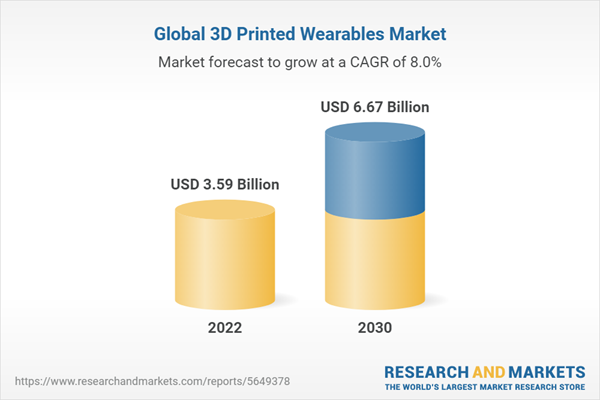Dublin, Jan. 24, 2024 (GLOBE NEWSWIRE) -- The "Global 3D Printed Wearables Market Size, Share & Trends Analysis Report by Product Type (Prosthetics, Orthopedic Implants), End-use (Hospital, Pharma & Biotech Companies), Region, and Segment Forecasts, 2023-2030" report has been added to ResearchAndMarkets.com's offering.
The global 3D printed wearables market size is expected to reach USD 6.67 billion by 2030, registering a CAGR of 8.0% during the forecast period. 3D printed wearable technology has witnessed high adoption in the healthcare industry. Due to numerous technological innovations in the sector, the market is expected to witness significant growth over the forecast period. 
North America accounted for the largest revenue share of over 40.0% in 2022 owing to the increasingly aging population, and numerous technological innovations in the devices such as the new hybrid 3D printing technology developed in Wyss Institute at Harvard University that provides more precision at low-cost manufacturing, and increasing investment in R&D. In addition, an increase in the scope of biomedical applications, collaborations between academic institutions and hospitals, and widespread R&D activities at the industrial and academic level have fueled the industry growth. Also, the presence of major players in the region contributed to market growth.
The COVID-19 pandemic has negatively affected industry growth. The pandemic has adversely affected the business operations and financial condition of the market players. In the first quarter of 2020, the COVID-19 outbreak disrupted the global supply chain of raw materials and manufacturing parts of 3D printing products. These factors resulted in an increase in the cost of the product due to the increase in the cost of raw materials and shipping charges. The third and fourth quarters of 2020 reflected a lucrative growth in the sales and revenue of the 3D printed products, which further improved due to the launch of advanced technological products at an affordable cost.
North America accounted for the largest revenue share of over 40.0% in 2021 owing to the increasingly aging population, and numerous technological innovations in the devices such as the new hybrid 3D printing technology developed in Wyss Institute at Harvard University that provides more precision at low-cost manufacturing, and increasing investment in R&D. In addition, an increase in the scope of biomedical applications, collaborations between academic institutions and hospitals, and widespread R&D activities at the industrial and academic level have fueled the industry growth. Also, the presence of major players in the region contributed to market growth.
3D Printed Wearables Market Report Highlights
- The prosthetics product type segment dominated the market in 2022 with a share of over 35.0% owing to the increasing demand for prosthetics implants in developing countries
- The orthopedic implants product type segment is anticipated to register the fastest growth rate of 10.1% over the forecast period
- The hospital end-user segment accounted for the largest revenue share of over 35.0% in 2022 and is anticipated to maintain its dominance over the forecast period as wireless sensor devices to monitor patients' health are likely to increase the ease of patient administration and patient comfort
- The pharma and biotech companies end-user segment is expected to register the fastest growth rate of 8.9% over the forecast period
- North America held the largest revenue share of over 40.0% in 2022. This can be attributed due to the rapid increase in the development of wearable devices to meet the growing demand for efficient healthcare in the country.
Key Attributes:
| Report Attribute | Details |
| No. of Pages | 100 |
| Forecast Period | 2022 - 2030 |
| Estimated Market Value (USD) in 2022 | $3.59 Billion |
| Forecasted Market Value (USD) by 2030 | $6.67 Billion |
| Compound Annual Growth Rate | 8.0% |
| Regions Covered | Global |
Key Topics Covered:
Chapter 1. Methodology and Scope
Chapter 2. Executive Summary
2.1. Market Outlook
2.2. Segment Outlook
2.2.1. Product type outlook
2.2.2. End use outlook
2.2.3. Regional outlook
2.3. Competitive Insights
Chapter 3. Global 3D Printed Wearables Market Variables, Trends & Scope
3.1. Market Lineage Outlook
3.1.1. Parent market outlook
3.1.2. Related/ancillary market outlook
3.2. Penetration & Growth Prospect Mapping
3.3. Market Dynamics
3.4. Global 3D Printed Wearables Market Analysis Tools
Chapter 4. Global 3D Printed Wearables: Product Type Estimates & Trend Analysis
4.1. Global 3D Printed Wearables Market: Key Takeaways
4.2. Global 3D Printed Wearables Market: Movement & Market Share Analysis, 2022 & 2030
4.3. Prosthetics
4.4. Orthopedic Implants
4.5. Surgical Instruments
4.6. Smart Watches
4.7. Fitness Trackers
Chapter 5. Global 3D Printed Wearables: End Use Estimates & Trend Analysis
5.1. Global 3D Printed Wearables Market: Key Takeaways
5.2. Global 3D Printed Wearables Market: Movement & Market Share Analysis, 2022 & 2030
5.3. Hospital
5.4. Pharma and Biotech companies
5.5. Academic Institutes
5.6. Others (medical and surgical centers)
Chapter 6. Global 3D Printed Wearables Market: Regional Estimates & Trend Analysis
Chapter 7. Competitive Landscape
7.1. Recent Developments & Impact Analysis, By Key Market Participants
7.2. Company/Competition Categorization
- 3D Systems
- ENVISIONTEC US
- Stratasys
- GENERAL ELECTRIC
- CYFUSE BIOMEDICAL
- Koninklijke Philips
- Zephyr Technologies & Solutions
- OMRON
- Everist Health
- BioTelemetry
For more information about this report visit https://www.researchandmarkets.com/r/h1vxpn
About ResearchAndMarkets.com
ResearchAndMarkets.com is the world's leading source for international market research reports and market data. We provide you with the latest data on international and regional markets, key industries, the top companies, new products and the latest trends.
Attachment
